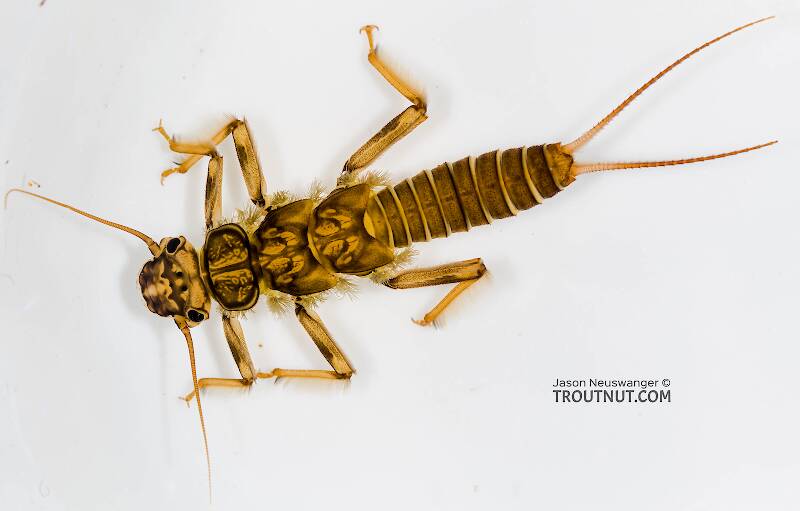
Blue-winged Olives
Baetis
Tiny Baetis mayflies are perhaps the most commonly encountered and imitated by anglers on all American trout streams due to their great abundance, widespread distribution, and trout-friendly emergence habits.

Mayfly Species Dannella simplex (Blue-Winged Olives)
Where & when
Time of year : June through mid-September, but best in June and July
In 21 records from GBIF, adults of this species have mostly been collected during July (38%), June (29%), August (14%), and April (10%).
In 5 records from GBIF, this species has been collected at elevations ranging from 3 to 2559 ft, with an average (median) of 2356 ft.
Species Range
Spinner behavior
Spinner falls are sparse and unimportant.Nymph biology
Current speed: Slow
Substrate: Silt
Physical description
Most physical descriptions on Troutnut are direct or slightly edited quotes from the original scientific sources describing or updating the species, although there may be errors in copying them to this website. Such descriptions aren't always definitive, because species often turn out to be more variable than the original describers observed. In some cases, only a single specimen was described! However, they are useful starting points.
Male Spinner
Wing length: 6 mm
A small, dark colored species; penes ending in two broad lobes, with minute papillae at the apices; nymph somewhat flattened, hairy, without occipital, thoracic or dorsal abdominal spines; gills on segments 4-7.
Eyes deep brown; head deep blackish brown. Thorax deep blackish brown; lateral margin of the mesonotum, and the dorsal transverse suture, pale brown. Mesosternum blackish brown in the central portion, light brown laterally between the middle and hind legs. Fore leg blackish; middle and hind legs dull yellowish brown; femur and tibia of hind leg subequal, tarsus two-thirds of the tibia. Wings hyaline; longitudinal veins brownish; cross veins apparent only in the stigmatic area. Abdominal tergites blackish brown, almost unicolorous, the lateral margins slightly paler; tergites 8 and 9 shaded with paler brown. Dull yellowish brown ventrally; sternite 9 shaded with blackish brown, as are also the forceps. Penes curve upward; each ends in a broad lobe, with a slight ventral heart-shaped depression just basad of the lobes; minute papillae are borne near the apex of each lobe (see fig. 157). Tails dull smoky.
Nymph
The nymph is rather broad and flat and very hairy. Pale olivaceous to deep brown in color, shaded variously with dark brown on the abdominal tergites. No occipital nor thoracic tubercles, nor dorsal abdominal spines are present. Genae considerably produced laterally. Femora rather chunky, the fore femora bearing a series of long hairs transversely across the middle. Femora with two dark bands; tibiae banded apically, tarsi with a median dark band. No denticles on the claws. Lateral extensions of the abdomen rather well developed, and bearing postero-lateral spines on segments 4-9. Gills borne on segments 4-7 only, that on segment 4 being rather strongly operculate. Markings of the tergites consist of interrupted dark submedian and lateral streaks which may broaden and coalesce. Sternites pale; unmarked, or with lateral rows of dark dashes. Tails pale, the joinings faintly ringed; with weak whorls of spinules and some fine fringing hairs apically.
Start a Discussion of Dannella simplex
References
- Arbona, Fred Jr. 1989. Mayflies, the Angler, and the Trout. Nick Lyons Books.
- Knopp, Malcolm and Robert Cormier. 1997. Mayflies: An Angler's Study of Trout Water Ephemeroptera . The Lyons Press.
- Leonard, Justin W. and Fannie A. Leonard. 1962. Mayflies of Michigan Trout Streams. Cranbrook Institute of Science.
- Needham, James G., Jay R. Traver, and Yin-Chi Hsu. 1935. The Biology of Mayflies. Comstock Publishing Company, Inc.
Mayfly Species Dannella simplex (Blue-Winged Olives)
Species Range
Resources
- NatureServe
- Integrated Taxonomic Information System
- Global Biodiversity Information Facility
- Described by McDunnough (1925)


